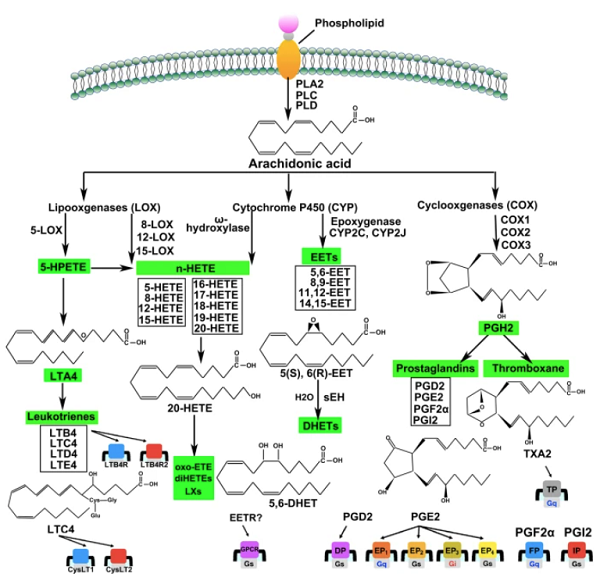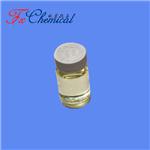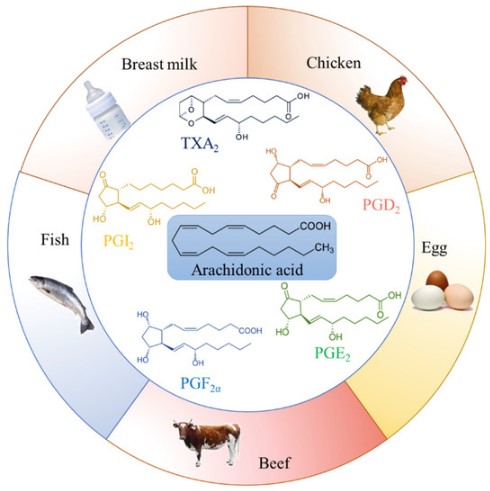The metabolism enzyme of Arachidonic acid
Introduction
Arachidonic acid (AA), also known as eicosatetraenoic acid (C20:4, ω−6), is an essential polyunsaturated fatty acid present in human tissue that is usually esterified as glycerolipids or glycerophospholipids to maintain the structure and function of the cell membrane. It was first named by J. Lewkowitsch in 1913; however, the exact structure was not elucidated until the 1940s. It is not only crucial for normal cellular membrane fluidity. Still, it is also a substrate for numerous enzymatic transformations that form biologically active lipid mediators such as prostaglandins (PGs), leukotrienes (LTs), epoxyeicosatetraenoic acids (EETs), and endocannabinoids (ECs).
Source
Arachidonic acid is obtained from poultry, animal organs, meat, fish, seafood, and eggs. It is incorporated in phospholipids in the cells' cytosol. It is adjacent to the endoplasmic reticulum membrane studded with the proteins necessary for phospholipid synthesis and their allocation to the diverse biological membranes.
The metabolism enzyme of arachidonic acid

The ω-6 polyunsaturated fatty acid (PUFA), arachidonic acid (AA), and its metabolites have attracted a lot of attention in cardiovascular and cancer biology, particularly in relation to inflammatory processes and disease. The importance of AA in biology lies in the fact that it can be metabolized by three distinct enzyme systems, i.e., cyclooxygenases (COXs, also referred to as PGG/H synthases), lipoxygenases (LOXs), and cytochrome P450 (CYP) enzymes (ω-hydroxylases and epoxygenases) to generate an impressive spectrum of biologically active fatty acid mediators.
The COXs, which generate prostanoids, i.e., prostaglandins (PGs) and thromboxane A2 (TXA2), were the first enzymes reported to metabolize AA. This requires the release of the lipid from the plasma membrane by phospholipases and subsequent metabolism by the COX enzymes to PGG2 and PGH2. The latter are then metabolized to PGs by specific PG synthases. There are two distinct COX isoforms; COX-1, constitutively expressed in most cells, is the dominant source of prostanoids that subserve housekeeping functions. On the other hand, COX-2 (also known as PTGS2) is induced by inflammatory stimuli, hormones, and growth factors and is generally assumed to be the more important source of prostanoid formation in inflammation and proliferative diseases, such as cancer. However, the situation is not black and white as both enzymes contribute to generating autoregulatory and homeostatic prostanoids, and both can contribute to prostanoids released during inflammation. Indeed, aspirin and non-steroidal anti-inflammatory drugs (NSAIDs), including inhibitors of COX-2, are effective in treating pain and inflammation.
The LOX pathway was the second eicosanoid and inflammatory pathway to be therapeutically targeted. The enzymes generate leukotrienes (LTs), first described in 1979 by Bengt I. Samuelsson, awarded the Nobel Prize in Physiology or Medicine in 1982. Arachidonate 5-LOX (or ALOX5) and LT receptor antagonists have been developed to treat asthma and seasonal allergies.
The third AA metabolizing pathway is the cytochrome P450 (CYP) pathway, which was first described in 1980. The CYP family of enzymes contains numerous subclasses, but the metabolism of AA ω-hydroxylase and epoxygenase activity are the most important. However, numerous CYP enzymes have mixed hyprolase and epoxygenase functions and are able to generate a mixed spectrum of products. The ω-hydroxylase activity of CYP enzymes converts AA to hydroxyeicosatetraenoic acids (HETEs). 20-HETEs is the best-studied metabolite in this context and has been shown to possess pro-inflammatory effects in addition to contributing to vascular function. The epoxygenase activity of CYP enzymes, such as the CYP2J and 2C families, generates AA epoxides or epoxyeicosatrienoic acids (EETs; 5,6-EET, 8,9-EET, 11,12-EET, and 14,15-EET). AA diols were initially thought to be less active than the epoxides, but it is now clear that the epoxide and diols may even exert antagonistic actions in some conditions. As the EETs are reported to elicit vasodilatation, this pathway and its metabolites are currently being targeted for the treatment of cardiovascular diseases (CVDs), including hypertension, heart failure (HF), and stroke. In addition, CYP-derived EETs also regulate some cellular processes of carcinogenesis and progression, including cell proliferation, survival, angiogenesis, invasion, and metastasis. CYP-derived EETs can also promote progenitor cell differentiation, proliferation, and migration, influencing capillary formation inflammation and apoptosis in endothelial cells. In this way, CYP-derived AA metabolites can contribute to tumour growth, progression, and metastasis.
[1] Yiran Zhang. “Arachidonic acid metabolism in health and disease.” MedComm 4 5 (2023).
[2] Hatem Tallima, Rashika El Ridi. “Arachidonic acid: Physiological roles and potential health benefits – A review.” Journal of Advanced Research 11 (2018): Pages 33-41.
[3] Bei Wang. “Metabolism pathways of arachidonic acids: mechanisms and potential therapeutic targets.” Signal Transduction and Targeted Therapy 6 1 (2021): 94.
References:
[1] BEI WANG. Metabolism pathways of arachidonic acids: mechanisms and potential therapeutic targets.[J]. Signal Transduction and Targeted Therapy, 2021, 6 1. DOI:10.1038/s41392-020-00443-w.[2] YIRAN ZHANG. Arachidonic acid metabolism in health and disease[J]. MedComm, 2023, 4 5. DOI:10.1002/mco2.363.
[3] HATEM TALLIMA R E R. Arachidonic acid: Physiological roles and potential health benefits – A review[J]. Journal of Advanced Research, 2018, 11: 1-90. DOI:10.1016/j.jare.2017.11.004.
You may like
Related articles And Qustion
See also
Lastest Price from Arachidonic acid manufacturers

US $0.00/KG2025-04-21
- CAS:
- 506-32-1
- Min. Order:
- 1KG
- Purity:
- 98%min
- Supply Ability:
- 30tons/month

US $10.00/KG2025-04-21
- CAS:
- 506-32-1
- Min. Order:
- 1KG
- Purity:
- 99%
- Supply Ability:
- 100 mt



